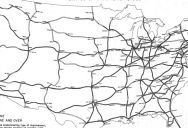Here’s How Interstates Are Numbered And The Logic Behind It
I don’t know about you, but my mind tends to wander on long interstate road trips. What is there to do besides stare out the window and see what there is to see, right?
One of the things you can’t help but see – in fact, you’re probably watching for them – are the numbered signs telling you what interstate you’re on and which ones are going to be coming up just down the road.

Image Credit: Pexels
If you’ve ever gotten to wondering how they’re given those numbers, don’t bail now – answers are coming.
The Dwight D. Eisenhower National System of Interstate and Defense Highways was approved by Congress in the Federal Aid Highway Act of 1956. They authorized around 41,000 miles of highways that spanned the entire contiguous United States, Alaska, Hawaii, and Puerto Rico.
The highways were first and foremost meant for national defense and the ability to speedily transport goods from coast to coast.
It was also a time of high anxiety as far as atomic attacks, and the highways would allow for many fast evacuation routes.
Lastly, it would make it easy for Americans to travel, and quickly.
Construction began on I-70 in Missouri and transformed life across the country. It gave rise to cargo trucking, gas stations, and truck stops, and also encouraged the massive growth of suburbs around big cities.

Image Credit: Public Domain
The numbers on all of those highways aren’t random though, and to better understand them, you can start with the number of digits in the name.
If there are one or two, the highway connects several regions.
Three? They’re meant to serve a single city and are technically called auxiliary interstate highways because they connect the two-digit highways.
What’s more? The last two digits will match their “parent” highway.
Even-numbered interstates stretch east-west and odds go north-south. Numbering for the former begins in the south and moves north, and for the latter, begin in the west and move east.
Fun fact: I-35 is the only interstate that splits as it goes through major cities – Minneapolis-St. Paul in the north and Dallas-Fort Worth in the south.
Also, the first digit of a three-digit interstate should give you a hint as to its purpose. If if begins with an odd number, it should connect or intersect only once. If it begins with an even, it will have bypasses and loops that intersect the “parent” at least twice.
Major interstate numbers are never repeated, but some shorter ones might exist in more than one state.

Image Credit: Creative Commons
The three-digit numbers can exist across the country, but can be used only once in the same state.
There are exceptions all over the place, most often in Alaska, Hawaii, and Puerto Rico (and California, because it’s so big and populous).
These rules apply only to interstate highways; every state has their own system for naming their highways, although many do conform to their own set of norms.
There you go – happy travels!

Sign up to get our BEST stories of the week straight to your inbox.




